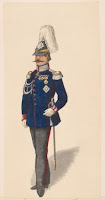The Prussian 7th (Magdeburg) Cuirassiers (left) and 3rd (East Prussian) Cuirassiers (right) join the establishment (Northstar 1866 Figures).
In this post, dear readers, I am gratified to report the completion of the aforementioned Prussian 1866 Cuirassier project. As expected, I did not complete these figs within the optimistic two week window. However, I can say that I did complete them earlier than doing this posting (so let's call it three weeks). As is the usual, I'll provide a study of how I did these figs and a bit of background on the units. I must also recommend that anyone interested should also visit Dean's WAB blog to see his superb rendition of these figures (which was both inspirational and aspirational for my own efforts). Moving on, here is my study of these figures. As usual, you may clix pix for BIG PIX
Although the Cuirassiers are among the highest prestige units of the Prussian Army, with lineages stretching back in some cases to the 1670s, tracing these regiments, post the 1806 Prussian Army reconstruction, is complicated, to say the least--much more so, for example, than the hussars, which also reach back a long way (to Frederick the Great's Army). The difference is that the hussars (for example) were either continued or eliminated--and new ones formed, so the history/lineage of each is fairly linear. With the cuirassiers, however, the original thirteen regiments (pre 1806) were amalgamated into four regiments for the Befreiungskriege (1813-14)--and then five more regiments were added afterwards (in 1819). Thus, the post-Napoleonic Prussian Army had nine cuirassier regiments (not counting the Garde du Corps) that persisted to the end of WWI, that amalgamated the traditions and lineages of old regiments. So please excuse the seemingly superficial treatment of the background information on these units...
7th Magdeburg Cuirassiers (Von Seydlitz)
Image of the 7th Cuirassiers in Von Bredow's "Death Ride" found on the Planet Figure Forum (unattributed).
The Magdeburg Cuirassiers are the darlings of any Post-Napoleonic Prussian Army. For anyone not familiar with their history, they along with the 17th Uhlans--who definitely get second billing--conducted the famous charge at the Battle of Mars La Tour known as Von Bredow's Death Ride. In terms of celebrated actions, this would be the Prussian version of the Charge of the Light Brigade (but in typically Prussian v British fashion, it was a calculated risk as opposed to a magnificent blunder). For anyone curious, I recommend that you follow the aforementioned links or check out the excellent post at Black Powder Games on the topic. The 7th Cuirassiers (Magdeburg) began as the 4th Cuirassiers in 1809, created from an amalgamation of squadrons from the pre-1806 Silesian, Brandenburg, and East Prussian Cuirassiers. They carried the silver kettle drums that came down through the old Leib Cuirassier Regiment. They were later renumbered as Cuirassier Rgt #7 in 1819. The "new" regiment's post 1806 battle record includes the wars of Liberation (1813/14), the Austro-Prussian War (1866), the Franco Prussian War (1870--where they did the "Death Ride"), and World War I. Suffice it to say that anyone building a post-Napoleonic Prussian Army would probably include these among their cuirassiers. And so did I...
3rd East Prussian Cuirassiers (Count Wrangel)
A good representation of what the 3rd (East Prussian) Cuirassiers would look like (only in white steel cuirasses).
Despite it's low number, the East Prussian Cuirassiers were a "new" regiment that was converted from dragoons to cuirassiers in 1818. Despite this "creation" in 1818, its lineage stretches back to a dragoon regiment formed in 1717, and it continued to carry the silver kettle drums that were captured from the Russians at the Battle of Zorndorf in 1758. Its battle honors include the Wars of Frederick the Great, the Befreiungskriege (1813/14), the Austro Prussian War (1866), the Franco Prussian War (1870), and World War I.
I very much liked the combination of the light blue facings (with white trim/button color) of this regiment, particularly next to the white on yellow of the 7th Cuirassiers. Given the higher contrast, I decided that this regiment would have the trumpeter (why do all that work if nobody can see it?).
Trumpeter/Command Figure
I did, of course, produce a trumpeter for the 7th--as is my tradition, I used the "spare" trumpeter as a command figure.
Display Figures
By the end of this painting project, the issues with my neck and shoulder had flared up (it sucks getting old). This was not a surprise; going in, I realized that given these issues that this would probably be my last major painting project. In the future, I'll probably only be doing one offs and specialty figures--no more units and armies. I've now got more than enough painted toys to play with :). Given these circumstances, I decided to paint a few extra figures and put them on a display stand representing the color party of the 3rd (East Prussian) Cuirassiers.
Although I don't have the space to line up my toy soldiers on display like some other gamers, I do have a display case with collectibles and other bits and bobs--these figures are on display there representing the rest of my little armies that are stowed away in boxes.















































